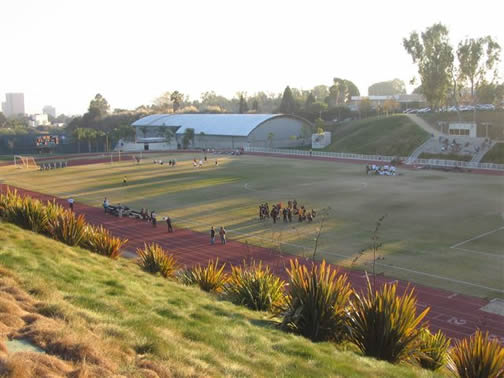VA commits to further Brentwood nuke dump study, though uncertainty remains
By Michael Collins
Los Angeles CityBeat – September 13, 2007

A full-blown $1 million study of a forgotten biomedical nuclear waste site in Brentwood will be done to more fully explore concerns raised in a preliminary report, it was revealed last week during a Department of Veterans Affairs gathering with several hundred people.
It was the first public meeting in Los Angeles in two years convened by the Department of Veterans Affairs to discuss the Bush administration’s initiatives regarding the VA campus. Local leaders, who have called the plans a blatant land-grab to line the pockets of developers, appear to have the upper hand. An amendment to the current VA appropriation bill by Sen. Dianne Feinstein protects the land from private development and is not expected to be vetoed by Bush.
Almost lost in the fray was the long-awaited release of the VA’s first-phase report on its biomedical nuclear waste site conducted in December to home in on the extent and nature of two decades of Cold War-era dumping on its Brentwood campus.
However, questions have emerged as to the accuracy of the so-called Phase One report, as well as the department’s commitment to unearthing the dump which contains of irradiated lab animals and equipment, buried trenches of nuclear waste, and countless containers of chemical toxins. That toxic material includes radioactive tritium as well as incinerated ash that were discarded in hodgepodge fashion from (1948) to 1968 in an area estimated to range from behind the Brentwood Theatre to under Barrington Dog Park and Brentwood School.
The Phase One report is at once illuminating and troublesome, if only for higher-than-expected surface radiation measurements in two areas other than the west arroyo near-center of the dump.
“The average readings for the East Arroyo, West Arroyo, and the Brentwood School lower soccer fields were notably above the Control areas,” according to Pleasant Hill-based Millennium Consulting, the Phase One testing contractor. “Based upon the historical documentation, physical evidence, anomalies in the ‘Walkover’ scan data for the Arroyo(s) and strong concern by members of the community, Millennium is recommending that additional surface and subsurface investigation and sampling be performed in these areas.”
Explaining the VA’s land program at the Wadsworth Theater was special assistant to the secretary Jay Halpern, who told a crowd gathered there that the long delay since the last “local advisory panel” meeting was due, in part, to unanswered questions about the dump raised by CityBeat (“Real Hot Property,” May 18, 2006). “There were other issues that we ran into that were much more complicated; certainly the issue around the radiation of Barrington Park, which we have addressed in the Phase One report coming out. Now we enter the Phase Two study to ensure that there is absolutely nothing underneath there.”
Millennium’s report is sometimes sloppy and riddled with problems caused by the VA’s lack of cooperation. The VA didn’t supply Millennium with some crucial source materials that could have been used in the preliminary analysis of the dump; two of these missing reports assessed the environmental conditions of Brentwood School and were included in more than 5,600 pages of VA documents released last month by Congressman Henry Waxman. These documents were disclosed to Waxman last December at about the same time Millennium conducted the Phase One tests. (See CityBeat’s “Nuke ‘Em High,” August 16.) The report also incorrectly identifies this reporter as working for “Los Angeles Times Beat” and places the site in the “City of Brentwood” instead of Los Angeles.
As reported, construction of a 2,500-foot drain in 1996 was halted on what is now part of the school’s football field, due to the extensive dumping of waste including used syringes and hypodermic needles. New information uncovered by CityBeat in a January 2000 environmental site assessment conducted by Santa Ana-based URS Greiner Woodward Clyde and not provided to Millennium, shows that this waste was quite extensive, according to Paul “Peanuts” Paxton who was a foreman on the construction project and was interviewed by URS in 1999. The report noted that Paxton, recalled one “debris pile was probably no more than 5 feet thick by less than 100 feet long” and was “encountered in an area roughly 200 to 300 feet south of the Brentwood School student parking lot.”
Much of this new information was unknown publicly until the release of Waxman’s documents.












Recent Comments